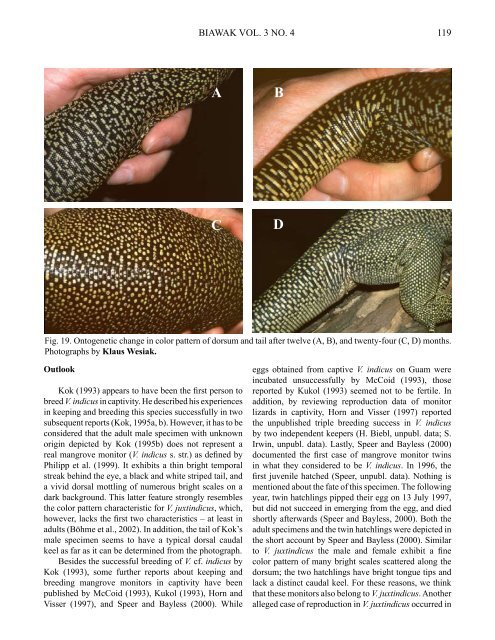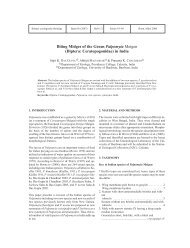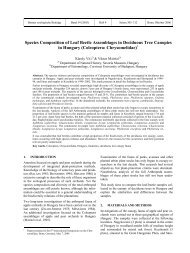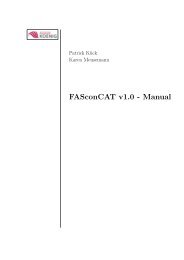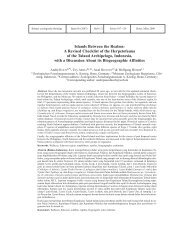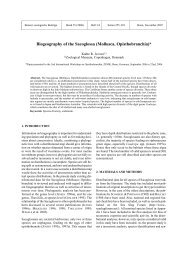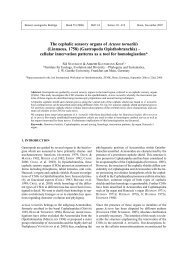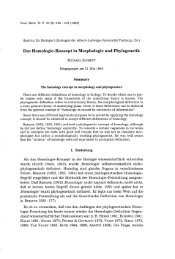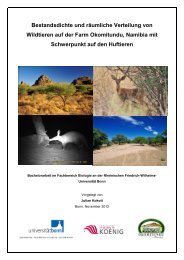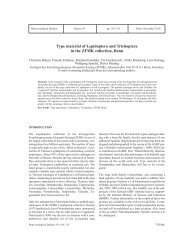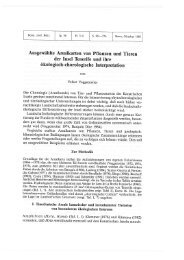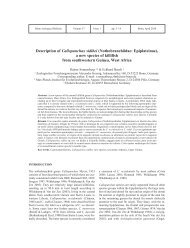Successful Husbandry and First Breeding of Varanus juxtindicus ...
Successful Husbandry and First Breeding of Varanus juxtindicus ...
Successful Husbandry and First Breeding of Varanus juxtindicus ...
Create successful ePaper yourself
Turn your PDF publications into a flip-book with our unique Google optimized e-Paper software.
Fig. 19. Ontogenetic change in color pattern <strong>of</strong> dorsum <strong>and</strong> tail after twelve (A, B), <strong>and</strong> twenty-four (C, D) months.<br />
Photographs by Klaus Wesiak.<br />
Outlook<br />
Kok (1993) appears to have been the first person to<br />
breed V. indicus in captivity. He described his experiences<br />
in keeping <strong>and</strong> breeding this species successfully in two<br />
subsequent reports (Kok, 1995a, b). However, it has to be<br />
considered that the adult male specimen with unknown<br />
origin depicted by Kok (1995b) does not represent a<br />
real mangrove monitor (V. indicus s. str.) as defined by<br />
Philipp et al. (1999). It exhibits a thin bright temporal<br />
streak behind the eye, a black <strong>and</strong> white striped tail, <strong>and</strong><br />
a vivid dorsal mottling <strong>of</strong> numerous bright scales on a<br />
dark background. This latter feature strongly resembles<br />
the color pattern characteristic for V. <strong>juxtindicus</strong>, which,<br />
however, lacks the first two characteristics – at least in<br />
adults (Böhme et al., 2002). In addition, the tail <strong>of</strong> Kok’s<br />
male specimen seems to have a typical dorsal caudal<br />
keel as far as it can be determined from the photograph.<br />
Besides the successful breeding <strong>of</strong> V. cf. indicus by<br />
Kok (1993), some further reports about keeping <strong>and</strong><br />
breeding mangrove monitors in captivity have been<br />
published by McCoid (1993), Kukol (1993), Horn <strong>and</strong><br />
Visser (1997), <strong>and</strong> Speer <strong>and</strong> Bayless (2000). While<br />
BIAWAK VOL. 3 NO. 4<br />
A B<br />
C D<br />
119<br />
eggs obtained from captive V. indicus on Guam were<br />
incubated unsuccessfully by McCoid (1993), those<br />
reported by Kukol (1993) seemed not to be fertile. In<br />
addition, by reviewing reproduction data <strong>of</strong> monitor<br />
lizards in captivity, Horn <strong>and</strong> Visser (1997) reported<br />
the unpublished triple breeding success in V. indicus<br />
by two independent keepers (H. Biebl, unpubl. data; S.<br />
Irwin, unpubl. data). Lastly, Speer <strong>and</strong> Bayless (2000)<br />
documented the first case <strong>of</strong> mangrove monitor twins<br />
in what they considered to be V. indicus. In 1996, the<br />
first juvenile hatched (Speer, unpubl. data). Nothing is<br />
mentioned about the fate <strong>of</strong> this specimen. The following<br />
year, twin hatchlings pipped their egg on 13 July 1997,<br />
but did not succeed in emerging from the egg, <strong>and</strong> died<br />
shortly afterwards (Speer <strong>and</strong> Bayless, 2000). Both the<br />
adult specimens <strong>and</strong> the twin hatchlings were depicted in<br />
the short account by Speer <strong>and</strong> Bayless (2000). Similar<br />
to V. <strong>juxtindicus</strong> the male <strong>and</strong> female exhibit a fine<br />
color pattern <strong>of</strong> many bright scales scattered along the<br />
dorsum; the two hatchlings have bright tongue tips <strong>and</strong><br />
lack a distinct caudal keel. For these reasons, we think<br />
that these monitors also belong to V. <strong>juxtindicus</strong>. Another<br />
alleged case <strong>of</strong> reproduction in V. <strong>juxtindicus</strong> occurred in


